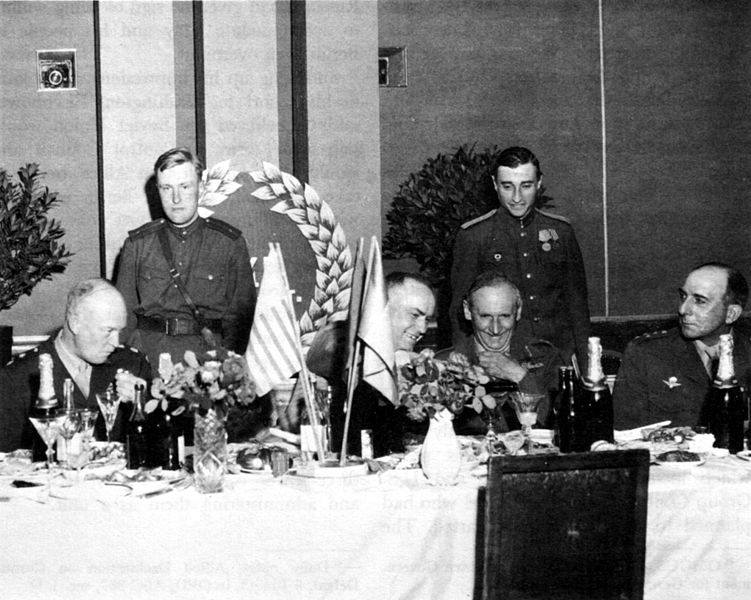<Back to Index>
- Member of the French Resistance Jean Moulin, 1899
- Lieutenant Colonel of the French Army Camille d'Ornano, 1900+
- Général d'Armée Jean Joseph Marie Gabriel de Lattre de Tassigny, 1889
PAGE SPONSOR
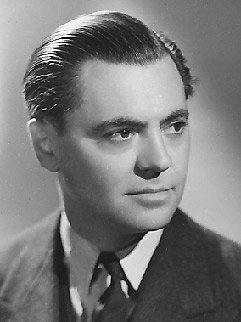
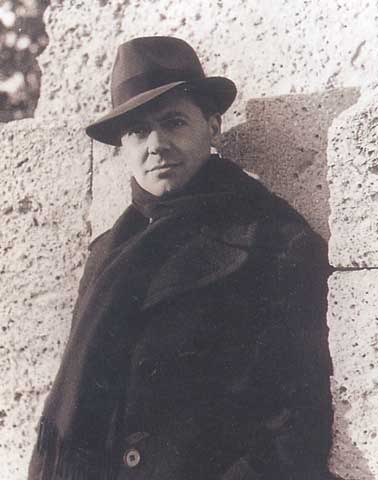
Jean Moulin (20 June 1899 – 8 July 1943) was a high profile member of the French Resistance during World War II. He is remembered today as an emblem of the Resistance, owing mainly to his role in unifying the French resistance under de Gaulle and his courage and death at the hands of the Gestapo.
Moulin was born in Béziers, France, and enlisted in the French Army in 1918. After World War I, he resumed his studies and obtained a degree in law in 1921. He then entered the prefectural administration as chef de cabinet to the deputy of Savoie in 1922, then as sous - préfet of Albertville, from 1925 to 1930. He was France's youngest sous - préfet at the time.
He married Marguerite Cerruti in September 1926, but the couple divorced in 1928.
In 1930, he was the sous - préfet of Châteaulin, Brittany. During that time, he also drew political cartoons in the newspaper Le Rire under the pseudonym Romanin. He also became an illustrator for the Breton poet Tristan Corbière's books; among other works he made an etching for La Pastorale de Conlie, Corbière's poem about the camp of Conlie where many Breton soldiers died in 1870. He also made friends with the Breton poets Saint - Pol - Roux in Camaret and Max Jacob in Quimper.
He became France's youngest préfet in the Aveyron département, based in the commune of Rodez, in January 1937.
Some claim that during the Spanish Civil War he supplied arms from the Soviet Union to Spain. A more commonly accepted version of events is that he supplied French planes to the Republican forces from his position in the aviation ministry.
In 1939, Moulin was appointed préfet of the Eure - et - Loir département. The Germans arrested him in June 1940 because he refused to sign a German document that falsely blamed Senegalese French Army troops for civilian massacres. In prison, he attempted suicide by cutting his throat with a piece of broken glass. This left him with a scar that he would often hide with a scarf — the image of Jean Moulin remembered today.
In November 1940, the Vichy government ordered all préfets to dismiss left wing elected mayors of towns and villages. When Moulin refused, he was himself removed from office.
He then lived in Saint - Andiol (Bouches - du - Rhône), and joined the French Resistance. Moulin reached London in September 1941 under the name Joseph Jean Mercier, and met General Charles de Gaulle, who asked him to unify the various resistance groups. On 1 January 1942, he parachuted into the Alpilles. Under the code names Rex and Max, he met with the leaders of the resistance groups:
- Henri Frenay (Combat)
- Emmanuel d'Astier (Libération)
- Jean - Pierre Lévy (Francs - tireurs)
- Pierre Villon (Front national, not to be confused with the present day far right French political party Front national)
- Pierre Brossolette (Comité d'action socialiste)
He succeeded to the extent that the first three of these resistance leaders and their groups came together to form the Mouvements Unis de la Résistance (M.U.R.) in January 1943. In February 1943, Moulin returned to London, accompanied by Charles Delestraint, head of the new Armée secrète which grouped together the M.U.R.'s military wings. He left London on 21 March 1943 with orders to form the Conseil national de la Résistance (CNR), a difficult task since the five resistance movements involved (beside the three already in the M.U.R.) wanted to retain their independence. The first meeting of the CNR took place in Paris on 27 May 1943.
In his work in shepherding the Resistance, Moulin was aided by his private administrative assistant Laure Diebold.
On 21 June 1943, Jean Moulin was arrested at a meeting with fellow Resistance leaders in the home of Doctor Frédéric Dugoujon in Caluire - et - Cuire, a suburb of Lyon. Moulin, Dugoujon, Henri Aubry (alias Avricourt and Thomas), Raymond Aubrac, Bruno Larat (alias Xavier - Laurent Parisot), André Lassagne (alias Lombard), Colonel Albert Lacaze, Colonel Emile Schwarzfeld (alias Blumstein) and René Hardy (alias Didot) were arrested.
Interrogated extensively in Lyon by Klaus Barbie, head of the Gestapo there, and later more briefly in Paris, Moulin never revealed anything to his captors. He died near Metz while on a train in transit towards Germany. The cause of death was injuries suffered either during torture or in a suicide attempt; Barbie alleged that suicide was the cause, and one Moulin biographer, Patrick Marnham, supports this explanation, though it is widely believed that Barbie personally beat Moulin to death.
René Hardy was caught and released by the Gestapo, who had followed him to the meeting at the doctor's house. Some believe that this was a deliberate act of treason; others think René Hardy was simply reckless. Two trials concluded that he was innocent. A recent TV film about the life and death of Jean Moulin depicted René Hardy collaborating with the Gestapo, thus reviving the controversy. The Hardy family attempted to bring a lawsuit against the producers of the movie.
There have been many allegations in the post war years that Moulin was a Communist. No hard evidence has ever backed up this claim. Marnham looked into the allegations, but found no evidence to support the assertion (though members of the party could easily have seen him as a 'fellow traveler' owing to his Communist friends and support for the Republican side in Spain). As préfet, Moulin even ordered the repression of Communist 'agitators' and went so far as to have police keep some under surveillance.
It has also been suggested, principally in Marnham's biography, that Moulin was betrayed by Communists. Marnham points the finger specifically at Raymond Aubrac and possibly his wife, Lucie Aubrac. He claims that Communists did at times betray non - Communists to the Gestapo and that Aubrac has been linked to harsh actions during the purge of collaborators after the war. In 1990, Klaus Barbie, by then a "bitter, dying Nazi" named Aubrac as the traitor.
To counteract the accusations leveled at Moulin, his personal secretary during the war, Daniel Cordier, has written his own biography of his former leader.
Moulin was initially buried in Père Lachaise Cemetery in Paris. His ashes were later transferred to The Panthéon on 19 December 1964. The speech given by André Malraux, writer and minister of the Republic, upon the transfer of his ashes is one of the most famous speeches in French history.
Today, Jean Moulin is used in French education to illustrate civic virtues, moral rectitude and patriotism. He is a symbol of the Resistance. Many schools and a university, as well as innumerable streets, squares and even a Paris tram station have been named after him. The Musée Jean Moulin commemorates his life and the Resistance. Jean Moulin is the third most popular name for a French Ecole primaire, Collège, and Lycée.
The Jean Pierre Melville film Army of Shadows (based on a book of the same name) depicts several famous events in Moulin's war experience, such as his visits to London, his reliance on his female assistant, his decoration by Charles de Gaulle and his parachuting back into France during the war. These events are not specifically attributed to Moulin, but the parallels are no doubt intentional, given the film's celebration of the resistance, and Moulin's iconic status. Jean Moulin became the most famous and honored French Resistance fighter. He is known by practically all French people, thanks to his famous monochrome photo, with his scarf and his fedora. Other martyrs of the clandestine fight, such as Pierre Brossolette, Jean Cavaillès or Jacques Bingen, all of them organizers of the underground army, are overshadowed by his legend. In 1993, a commemorative French two franc coin was issued showing a partial image of Moulin against the Croix de Lorraine. The image was based on the iconic fedora and scarf photograph.
Camille d'Ornano was a Lieutenant Colonel in the French Army leading up to the Second World War. He had been appointed as commander of the Chad garrison prior to the initiation of hostilities. During the war he supported the Free French, his actions including the participation and co-leading a successful attack on Kufra.
After the war he was named High Commissioner of the French Territory of the Afars and Issas (1976 – 1977), which became the independent country of Djibouti on 27 June 1977.
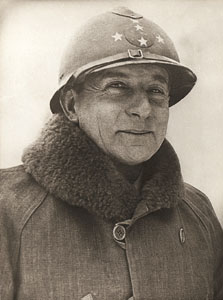
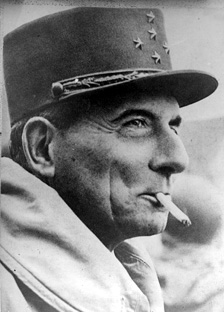
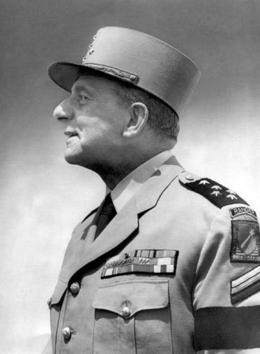
Jean Joseph Marie Gabriel de Lattre de Tassigny, GCB, MC (2 February 1889 – 11 January 1952) was a French military hero of World War II and commander in the First Indochina War.
Born at Mouilleron - en - Pareds (Vendée), in the same village of WWI leader Georges Clemenceau, to an aristocratic family, he graduated from officer school in 1911 (ranked 5th in his class in Saint - Cyr), fought in World War I and was wounded twice. He specialized in cavalry and was made head of the French War College in 1935. After World War I, he served as an officer in the French headquarters during the Rif War.
He entered General Weygand's headquarters in 1932. Weygand had the choice between de Lattre and de Gaulle and chose de Lattre because of his superior rank and honors. De Lattre then served in the headquarters of an infantry regiment at Metz.
When war was declared in 1939, he commanded the French 14th Infantry Division until the armistice with the Axis troops. He won a minor battle in Rethel where a German officer said that the French resistance was similar to the Battle of Verdun.
He remained on active duty, commanding Vichy French forces in Tunisia in 1941. He took charge of the 16th Division in 1942, but began organizing an anti - German force, which led to his arrest and a 10 year jail sentence. However, de Lattre was able to escape to Algiers. There he took command of the French Army B. French Army B were one of two armies of the Southern Group of Armies, also known as the Sixth United States Army Group. The Sixth Army Group was set up to organize the invasion of Southern France in Operation Dragoon. The other unit comprising the formation was the US Seventh Army, commanded by Alexander M. Patch. Before that, elements of de Lattre's army took Corsica. De Lattre then landed in Provence, southern France on 16 August 1944, and his troops began marching through France liberating the country as they went. On 25 September 1944 French Army B was redesignated French First Army. The army crossed the Vosges after heavy fighting. De Lattre took Belfort but halted the progress of his army. In doing so, he allowed the Germans to form the Colmar Pocket. During December 1944, the attempts to take Colmar were unsuccessful. De Lattre was able to collapse the pocket in January and February 1945 after the successful defense of Strasbourg, which was defended on the north by American troops and the French 3rd DIA and on the south by the French.
Under General de Gaulle's encouragement those French Resistance members who wished to continue fighting were incorporated into the French First Army by General de Lattre. Once France had been liberated, as part of the Alliance, his army crossed the Rhine and invaded Germany. In Germany, his army, now numbering more than 320,000 soldiers took Karlsruhe, Ulm and Stuttgart before crossing the Danube and arriving in Austria. De Lattre represented France at the German unconditional surrender in Berlin on 8 May 1945.
After World War II, he first became chief of staff of the NATO infantry in Europe. He was under the orders of Field Marshal Montgomery, organizing numerous training exercises. He also served as a French military ambassador in South America. Then, he commanded French troops in Indochina during the First Indochina War. He won three major victories at Vinh Yen, Mao khé and Yen Cu Ha and defended successfully the north of the country against the Viet Minh but his only son, Bernard de Lattre de Tassigny, was killed in action during the war at the Battle for Nam Dinh. In 1951, illness forced de Lattre de Tassigny to return to Paris where he later died of cancer; he was posthumously made Maréchal de France. After his return to France, his successors Raoul Salan and Henri Navarre did not enjoy the same level of success as de Lattre did.
Jean de Lattre de Tassigny was buried in a state funeral lasting five days, in what LIFE magazine described as the "biggest military funeral France had seen since the death of Marshal Foch in 1929". The Marshal's body was conveyed through the streets of Paris in a series of funeral processions, with the coffin lying in state at four separate locations: his home, the chapel at Les Invalides, the Arc de Triomphe and before Notre Dame. Those marching in the funeral processions, following the gun carriage on which the tricolor covered coffin was carried, included members of the French cabinet, judges, bishops and Western military leaders. The pallbearers included other Allied generals of World War II, such as Bernard Montgomery and Dwight D. Eisenhower. The route included the Rue de Rivoli and the Champs - Élysées, and the processions went from the Arc de Triomphe to Notre Dame, and then from Notre Dame to Les Invalides. The stage of the journey from the Arc de Triomphe to Notre Dame took place in the evening, and cavalrymen from the Garde Républicaine flanked the coffin on horseback bearing flaming torches. Walking behind the soldiers marching in the funeral processions was the lone figure of the Marshal's widow, Simonne de Lattre de Tassigny, dressed in black and praying as she walked. Thousands of people lined the funeral route, forming crowds standing ten - deep. The pageantry included the tolling of bells, and flags being flown at half-mast. The final stage of the funeral was a journey of 250 miles to the Marshal's birthplace of Mouilleron - en - Pareds in western France. In attendance there was the Marshal's 97 year old father, Roger de Lattre. Aged and blind, and the last of the de Lattres, he ran his hands over the ceremonial accoutrements on the coffin, which included the posthumously awarded marshal's baton and his son's kepi. Then the coffin was lowered into the ground and the Marshal was laid to rest beside his only son, Bernard, who had been killed fighting under his father's command in Indochina some eight months previously.
Numerous memorials have been erected to the memory of Jean de Lattre. An annual military service, involving serving soldiers, veteran associations, and ceremonial carriage of the Marshal's baton, takes place at the graves of the de Lattre family in Jean de Lattre's birthplace of Mouilleron - en - Pareds.
